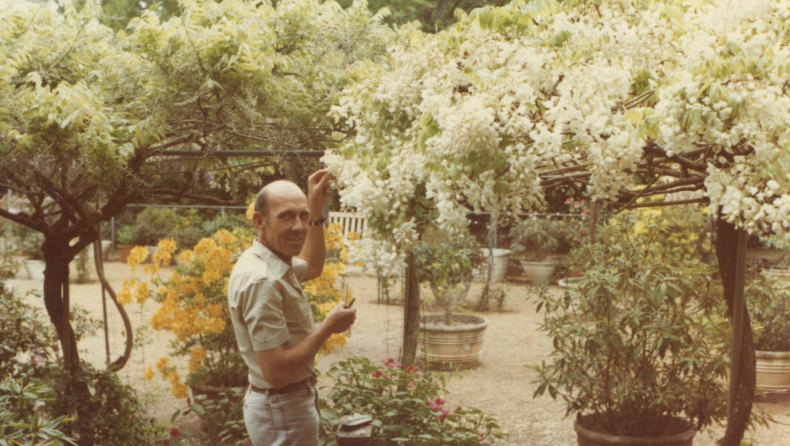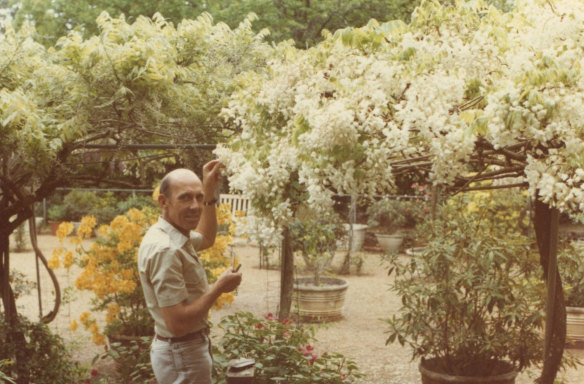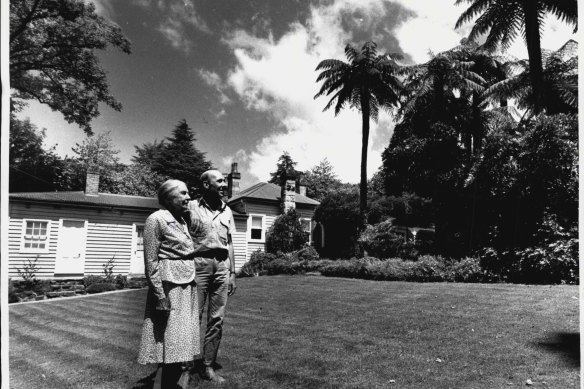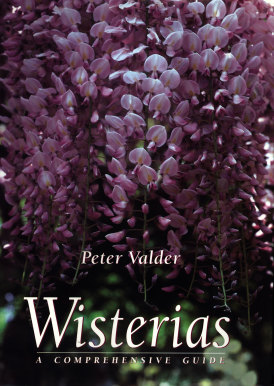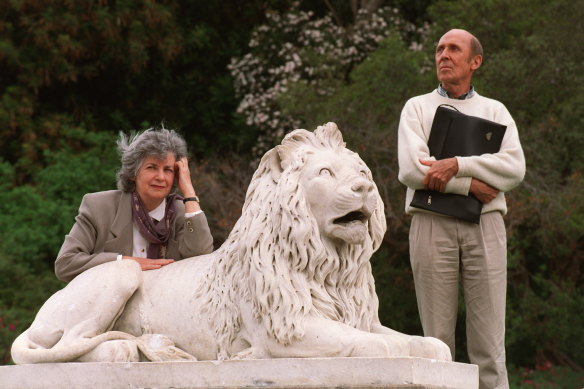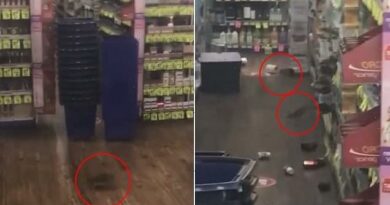TV horticulturist famed for Burke’s Backyard appearances dead at 94
Save articles for later
Add articles to your saved list and come back to them any time.
PETER VALDER: 1928-2023
Dr Peter Valder OAM, mycologist, botanist, horticulturist, lecturer, author, television presenter and wit, and for 55 years the much loved partner of Allan McNeish, had horticulture in his genes.
Few who were there could forget his after dinner speech at the 2004 Australian Garden History Society annual conference at the Queen Victoria tearooms in Sydney. His topic was “Garden Visiting”. He related how in 1955, while a student at Cambridge he was on a National Trust tour of Scottish gardens.
Peter Valder in the wisteria garden at Nooroo.
He was the only person on the bus who didn’t have a title or a hyphenated, even double-hyphenated, surname. As a young, fit colonial he was dispatched to find two of the party who hadn’t returned to the bus at the appointed time, only to find the garden lovers “in flagrante” in the shrubbery. It took five minutes for the laughter to subside.
Later on in the tour a duchess asked him where he was from. “New South Wales” said Peter. “Oh, I have a brother working out there”. “What does he do?” asked Peter. “He’s the Governor; give him my love when you see him.”
Peter Valder’s grandfather, George Valder, was director of Hawkesbury Agricultural College, and then Under Secretary of the NSW Department of Agriculture. He had extensive land holdings at Mt Wilson, and in 1919 bought the established property Nooroo, which he handed over to his son, also George, in 1919, after his return from the First World War. George married Isa Watson in 1925, and Peter was born at Mt Wilson in 1928, followed by brother John in 1931.
Peter Valder and his mother in the garden of Nooroo.Credit: Fairfax
Peter’s father had been trained as an orchardist at the Bathurst Experimental Farm and developed Nooroo as an apple and pear orchard, sending the produce, including chestnuts, to the Sydney markets. Copious seasonal vegetables and cows, chooks, pigs, horses and bees made the family almost self-sufficient in food.
Peter and John grew up at Mt Wilson surrounded by gardens and bush. It was, in Peter’s words, “a magical, innocent time”.
Following in his father’s footsteps, Peter went to Shore for his secondary education, and obtained a traineeship with the Department of Agriculture, which included a scholarship to Sydney University to study plant pathology. He was a brilliant student and won the University Medal for Agricultural Science in 1951. A scholarship to Cambridge followed where he competed a PhD in 1954.
His leisure time was spent visiting famous gardens in the UK and Europe and formulating ideas about landscape design. He returned to Sydney in 1956 and did laboratory work at the Department of Agriculture on diseases in wheat until he returned to Sydney University in 1963 as senior lecturer in botany and mycology, where he remained until he retired in 1988.
Cover of Peter Valder’s book “Wisterias”Credit: Fairfax
He deliberately didn’t apply for promotion to a professorship, with its requirement to do research, in order to devote himself to teaching, which he saw as his vocation. He took the approach that an audience’s mind is more open to new ideas when laughing and he was a master of the double entendre. His students loved him.
In the 1970s first year biology lectures were via pre-recorded video lectures. Students were surprised to see Valder on screen “tiptoeing in Sydney Harbour in speedos while talking about algae.” Lecture rooms were tight at Sydney University in the 1970s and his botany lecture for his class of 19 was scheduled for 1pm in a 500-seat lecture theatre. As word spread around campus that Valder’s lectures were great lunchtime entertainment, his students had to arrive early to get a seat.
As his father grew older he gradually took over responsibility for the Nooroo garden, which in the years after the war had morphed into a cut-flower garden to supply Sydney’s burgeoning florist shops. A severe snow storm in 1965 caused enormous damage, but provided the opportunity to open up the garden and transform what, as Peter said, was “a plant-person’s collection into an orderly designed garden”.
In this he was strongly influenced by his friend Richard Clough, Professor of Landscape Architecture at the University of NSW. A major change was to covert the tennis court into a spectacular wisteria garden with a collection of rare Japanese wisteria which Peter had collected in Japan. Valder had a special interest in wisteria. His much lauded book, Wisteria: A Comprehensive Guide was the first monograph of the genus in a European language.
Friends of the Botanic Gardens Margot Child and Peter Valder at the entrance to the rose gardens, 1997.Credit: Fairfax
Upon the sale of Nooroo in 1992, he gave a collection of 20 of his Japanese wisteria to the Sydney Botanical Gardens, where a new pergola was designed for them in the revitalised Oriental Garden. He was a valued friend of the Gardens and in 1995 was made its first Honorary Horticulture Associate.
In order to raise funds for the upkeep of Nooroo after his father’s death, Peter, with assistance from Allen, opened the garden for two months in autumn and spring each year and attracted a large loyal following.
Mrs Valder enjoyed sitting at the gate collecting the entry fees and talking to visitors. In 1980, to mark the centenary of the garden, Peter commissioned Richard Clough to design a distinctive gazebo, which was featured in the 1989 Australia Post series of stamps devoted to Australian gardens.
In 1983 Peter’s reputation as an entertaining communicator of information about plants and gardening caught the attention of nurseryman Don Burke, who had unsuccessfully submitted a pilot for a weekly gardening program to Channel 9. When he included a rather risqué segment by Peter about peeling bananas, it was immediately approved, and Peter appeared regularly on Burke’s Backyard for 17 years.
This in turn lead to an invitation from a Chinese tour company for Peter to lead garden tours to the country. The three tours were fully booked, with many doing all three. The travellers had the advantage of briefing themselves beforehand with Peter’s two books on Chinese horticulture. The first one, The Garden Plants of China (1999), documented the history and use of more than 400 plants grown in Chinese gardens. The Gardens of China (2002) gave a comprehensive description of over 200 gardens which Peter had visited and photographed.
Peter was a foundation member of the Australian Garden History Society, and while never actively involved in any committee or program he was ever ready to support the society when asked, such as giving after dinner speeches.
Peter was highly esteemed as a horticultural scholar and plantsman; he was widely admired as an inspiring teacher and self-deprecating wit, and was revered by family and friends for his humility and bonhomie.
He is survived by nieces Bronwyn and Caroline and nephew Andrew and seven grandnieces and nephews. His ashes will be scattered at Mt Wilson in the spring when the wisterias are in flower.
The Opinion newsletter is a weekly wrap of views that will challenge, champion and inform your own. Sign up here.
Most Viewed in National
From our partners
Source: Read Full Article
